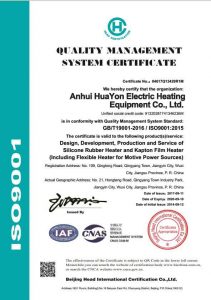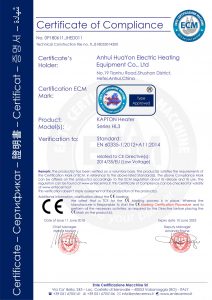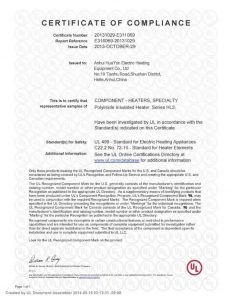Calentador de caucho de silicona para solución de calentador de batería Detalle rápido
Applicable Industries: medicine and healthcare, aerospace and aviation, Automotive industry, Consumer electronics
state: New
Type: electric heater
Birthplace:Anhui, China
brand name: HuaYon customize it
Dimension (L*W*H): personalized
Voltage: 3,7 ~ 480 V
1 one year warranty
Working temperature range: -30~200ºC
Material: Silicone rubber + engraved metal sheet
Thickness: 1,5-3 mm
Back adhesive: 3M 467/468 the personalized
Power density: 0,01-2,5 w/cm²
Power deviation: ±5%
Supply capacity: 50000 units per month
Packaging Details: inner PE bag + card
Certificates: THIS, RoHS, ISO9001
Silicone rubber heater is a type of thin film that heats up when electrified, in a standard thickness of 1.5 mm, Adopting nickel-chromium wires or nickel-chromium foils from 0.05 mm ~ 0.10 mm thick engraved in certain shapes, the heating component is wrapped with heat conductors and insulating materials on both sides, and completed in high temperature die forming and aging heat treatment.
Voltage | 3V-480V | Thickness | 1.5mm-3mm |
Power Density | 0.1-1.2W/CM2 | Insulation Ohm | More than 5MΩ |
Min Size | 10*10mm | Max Temperature | 250 degree |
Max Size | 2000*10000mm | Wire Tension | 15N*15N |
What is silicone rubber heater?
Freeze protection and condensation prevention for many types of instrumentation and equipment.
Medical equipment such as blood analyzers and test tube warmers.
Computer peripherals such as laser printers.
Curing of plastic laminates.
Photo Processing Equipment.
Semiconductor Processing Equipment.
Thermal transfer equipment
Drums and other containers and viscosity control and asphalt storage.
Key features and benefits of silicone rubber heaters include:
Flexibility: The flexibility of silicone rubber allows for molding, bend or mold these heaters to fit various shapes and surfaces. This feature makes them suitable for applications where rigid heaters are not practical..
Uniform heating: These heaters distribute heat evenly across their entire surface., mitigating the appearance of hot spots or cold regions and ensuring constant heating.
Quick response to heating: Silicone rubber heaters are known for their fast response times in reaching and adjusting temperatures., making them suitable for applications requiring rapid heating adjustments.
Durability: silicone rubber is resistant to various environmental factors, like humidity, chemicals and moderate physical wear, which improves the robustness of the heater.
Electrical isolation: The electrical insulating properties of silicone rubber ensure safe use in applications where electrical insulation is vital.
Customizable layout: Manufacturers can customize silicone rubber heaters in terms of size, form, power and temperature distribution to meet specific heating requirements.
Silicone rubber heaters are used in a wide spectrum of industries and applications, including:
Industrial processes: Heat tanks, pipelines, valves and manufacturing equipment, and assist in curing operations, drying and preheating.
Medical devices: They are used in medical equipment as IV bag warmers, heated patient warmers and medical imaging tables.
Aerospace and aviation: preventing ice buildup on aircraft components by deicing critical areas such as wings.
Food and beverage industry: maintenance of specific temperatures in food processing equipment, such as boilers and tanks, during production processes.
electronics: Integration in electronic cabinets, display panels and other devices for temperature regulation.
Automotive section: Used in seat heating applications, defrosting windows and preheating engines in vehicles.
Manufacturers produce silicone rubber heaters incorporating resistive heating elements (of ten made of nickel-chromium alloy) between layers of silicone rubber. Later, These layers are vulcanized or bonded to create a unique, flexible heating unit., allowing precise control over the heating pattern and watt density of the heater.
Selecting a silicone rubber heater for a specific application requires considering factors such as operating temperature range, the required power, physical dimensions and environmental conditions for optimal performance.
Custom silicone rubber heaters with adhesive are specialized heating elements designed for applications requiring a flexible heating solution, durable and heat resistant. These heaters are usually made by attaching a resistive heating element (like a wire or etched sheet) between layers of silicone rubber, providing excellent thermal properties, flexibility and insulation.
¿Qué es el calentador de caucho de silicona para la solución de calentador de batería?
Un calentador de caucho de silicona para solución de calentador de batería es un tipo de elemento calefactor flexible diseñado específicamente para proporcionar calor a las baterías en diversas aplicaciones. Estos calentadores están fabricados con material de caucho de silicona que contiene elementos calefactores integrados, usually made of resistance wire or etched sheet, They produce heat when an electric current passes through them.
The purpose of these heaters is to keep the batteries in an optimal temperature range., especially in cold environments where low temperatures can negatively affect battery performance. Cold temperatures can reduce the efficiency and overall capacity of batteries, afectando su capacidad para entregar energía o almacenarla de manera efectiva.
Los calentadores de caucho de silicona ofrecen varias ventajas para las soluciones de calentamiento de baterías:
Flexibility: Estos calentadores son flexibles y se pueden fabricar en diferentes formas y tamaños para adaptarse a varios tamaños y configuraciones de baterías.
Uniform heating: Proporcionan una distribución uniforme del calor en toda la superficie de la batería, lo que ayuda a evitar puntos calientes o un calentamiento desigual que podría dañar la batería.
Resistencia a factores ambientales: el caucho de silicona es conocido por su durabilidad y resistencia a la humedad, los productos químicos y muchos factores ambientales, lo que hace que estos calentadores sean adecuados para diversas condiciones de funcionamiento.
Facilidad de instalación: Son fáciles de instalar y pueden adherirse directamente a la batería o colocarse en estrecho contacto con ella, asegurando una transferencia de calor eficiente.
Energy efficiency: Estos calentadores están diseñados para ser energéticamente eficientes, providing the necessary heat without consuming excessive energy.
![]()
![]()
![]()
![]()





Reviews
There are no reviews yet.